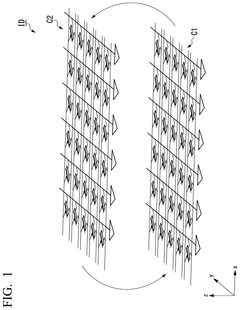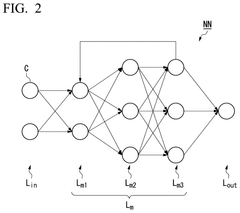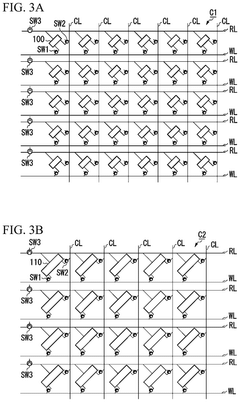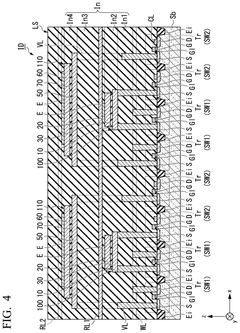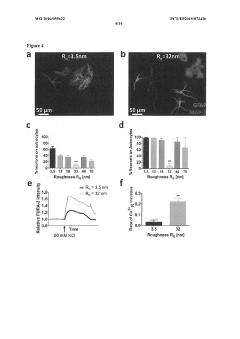Regulatory challenges facing neuromorphic materials deployment
SEP 19, 20259 MIN READ
Generate Your Research Report Instantly with AI Agent
Patsnap Eureka helps you evaluate technical feasibility & market potential.
Neuromorphic Materials Regulatory Landscape and Objectives
Neuromorphic computing represents a paradigm shift in computational architecture, drawing inspiration from the human brain's neural networks to create more efficient and adaptive systems. The evolution of this field has been marked by significant advancements in materials science, with researchers developing novel materials capable of mimicking synaptic functions. However, as these technologies progress from laboratory experiments to commercial applications, they face an increasingly complex regulatory landscape that must be navigated carefully.
The regulatory framework surrounding neuromorphic materials spans multiple domains, including environmental safety, electronic device standards, medical device regulations (for neural interfaces), and data privacy considerations. Currently, these materials exist in a regulatory gray area, as existing frameworks were not designed with brain-inspired computing architectures in mind. This creates uncertainty for developers and potential barriers to market entry.
Historical trends in technology regulation suggest that neuromorphic computing will likely face increasing scrutiny as applications expand. Early regulatory approaches to semiconductor technologies focused primarily on trade controls and intellectual property protection, but modern regulatory concerns have expanded to include environmental impact, supply chain security, and ethical considerations. The trajectory indicates a move toward more comprehensive governance structures that address both technical performance and societal implications.
The primary objective in addressing these regulatory challenges is to establish clear, science-based frameworks that ensure safety and compliance without stifling innovation. This requires identifying specific properties of neuromorphic materials that may trigger regulatory concerns, such as novel nanomaterials, potential environmental persistence, or unique electromagnetic properties that current standards may not adequately address.
Another critical goal is international harmonization of regulatory approaches. The global nature of technology development necessitates coordinated regulatory strategies to prevent fragmentation that could impede deployment. Organizations such as the IEEE, ISO, and various national standards bodies have begun preliminary work on neuromorphic computing standards, but comprehensive regulatory frameworks remain underdeveloped.
Achieving regulatory clarity will require collaborative efforts between industry stakeholders, academic researchers, and regulatory authorities to develop appropriate testing methodologies, safety assessments, and performance standards specifically tailored to neuromorphic materials and systems. This process must balance protection of public interests with the need to foster continued innovation in this promising field.
The regulatory framework surrounding neuromorphic materials spans multiple domains, including environmental safety, electronic device standards, medical device regulations (for neural interfaces), and data privacy considerations. Currently, these materials exist in a regulatory gray area, as existing frameworks were not designed with brain-inspired computing architectures in mind. This creates uncertainty for developers and potential barriers to market entry.
Historical trends in technology regulation suggest that neuromorphic computing will likely face increasing scrutiny as applications expand. Early regulatory approaches to semiconductor technologies focused primarily on trade controls and intellectual property protection, but modern regulatory concerns have expanded to include environmental impact, supply chain security, and ethical considerations. The trajectory indicates a move toward more comprehensive governance structures that address both technical performance and societal implications.
The primary objective in addressing these regulatory challenges is to establish clear, science-based frameworks that ensure safety and compliance without stifling innovation. This requires identifying specific properties of neuromorphic materials that may trigger regulatory concerns, such as novel nanomaterials, potential environmental persistence, or unique electromagnetic properties that current standards may not adequately address.
Another critical goal is international harmonization of regulatory approaches. The global nature of technology development necessitates coordinated regulatory strategies to prevent fragmentation that could impede deployment. Organizations such as the IEEE, ISO, and various national standards bodies have begun preliminary work on neuromorphic computing standards, but comprehensive regulatory frameworks remain underdeveloped.
Achieving regulatory clarity will require collaborative efforts between industry stakeholders, academic researchers, and regulatory authorities to develop appropriate testing methodologies, safety assessments, and performance standards specifically tailored to neuromorphic materials and systems. This process must balance protection of public interests with the need to foster continued innovation in this promising field.
Market Demand Analysis for Brain-Inspired Computing Solutions
The global market for brain-inspired computing solutions is experiencing unprecedented growth, driven by increasing demands for energy-efficient computing architectures capable of handling complex AI workloads. Current projections indicate the neuromorphic computing market will reach $8.2 billion by 2028, with a compound annual growth rate of 23.7% from 2023. This remarkable expansion reflects the urgent need for computing paradigms that transcend the limitations of traditional von Neumann architectures.
Healthcare represents one of the most promising sectors for neuromorphic technology adoption, particularly in medical imaging analysis, patient monitoring systems, and drug discovery processes. The ability of neuromorphic systems to process sensory data in real-time while consuming minimal power makes them ideal for portable medical devices and implantable neural interfaces, addressing a market segment valued at approximately $3.4 billion.
Autonomous vehicles and advanced driver-assistance systems constitute another significant market driver. These applications require instantaneous processing of multiple sensory inputs with strict power constraints – precisely the strengths of neuromorphic computing. Industry analysts estimate that by 2026, over 40% of new vehicles will incorporate some form of neuromorphic processing elements to enhance perception systems.
Edge computing applications represent perhaps the most immediate commercial opportunity. As IoT device deployments continue to accelerate, the demand for local, energy-efficient processing capabilities grows proportionally. Neuromorphic solutions offer 50-100x improvements in energy efficiency compared to conventional processors for certain pattern recognition and inference tasks, making them particularly attractive for battery-powered edge devices.
The defense and security sectors are also significant market drivers, with substantial investments in neuromorphic technologies for applications ranging from autonomous drones to signal intelligence systems. Government funding in this space exceeded $1.2 billion globally in 2022, with continued growth expected as geopolitical competition in advanced computing intensifies.
Enterprise data centers represent an emerging market segment, with companies seeking neuromorphic accelerators to reduce the enormous energy consumption associated with large-scale AI workloads. With data center energy usage accounting for approximately 1% of global electricity consumption, the potential market for more efficient computing architectures is substantial.
Despite this promising outlook, market adoption faces significant barriers, including the need for new programming paradigms, limited software ecosystems, and concerns regarding regulatory compliance of novel materials. The market currently exhibits a gap between research interest and commercial deployment, with most end-users adopting a "wait and see" approach while the technology matures and regulatory frameworks evolve.
Healthcare represents one of the most promising sectors for neuromorphic technology adoption, particularly in medical imaging analysis, patient monitoring systems, and drug discovery processes. The ability of neuromorphic systems to process sensory data in real-time while consuming minimal power makes them ideal for portable medical devices and implantable neural interfaces, addressing a market segment valued at approximately $3.4 billion.
Autonomous vehicles and advanced driver-assistance systems constitute another significant market driver. These applications require instantaneous processing of multiple sensory inputs with strict power constraints – precisely the strengths of neuromorphic computing. Industry analysts estimate that by 2026, over 40% of new vehicles will incorporate some form of neuromorphic processing elements to enhance perception systems.
Edge computing applications represent perhaps the most immediate commercial opportunity. As IoT device deployments continue to accelerate, the demand for local, energy-efficient processing capabilities grows proportionally. Neuromorphic solutions offer 50-100x improvements in energy efficiency compared to conventional processors for certain pattern recognition and inference tasks, making them particularly attractive for battery-powered edge devices.
The defense and security sectors are also significant market drivers, with substantial investments in neuromorphic technologies for applications ranging from autonomous drones to signal intelligence systems. Government funding in this space exceeded $1.2 billion globally in 2022, with continued growth expected as geopolitical competition in advanced computing intensifies.
Enterprise data centers represent an emerging market segment, with companies seeking neuromorphic accelerators to reduce the enormous energy consumption associated with large-scale AI workloads. With data center energy usage accounting for approximately 1% of global electricity consumption, the potential market for more efficient computing architectures is substantial.
Despite this promising outlook, market adoption faces significant barriers, including the need for new programming paradigms, limited software ecosystems, and concerns regarding regulatory compliance of novel materials. The market currently exhibits a gap between research interest and commercial deployment, with most end-users adopting a "wait and see" approach while the technology matures and regulatory frameworks evolve.
Regulatory Hurdles and Technical Limitations in Neuromorphic Materials
The deployment of neuromorphic materials faces significant regulatory challenges that intersect with inherent technical limitations. Current regulatory frameworks across major markets were not designed with neuromorphic computing in mind, creating a complex landscape for innovators. In the United States, the FDA has yet to establish clear guidelines for neuromorphic materials in medical applications, while the EU's regulatory approach under GDPR raises questions about data processing in brain-inspired computing systems that learn and adapt autonomously.
Safety certification presents another major hurdle, as traditional testing protocols cannot adequately assess self-modifying systems that evolve their behavior over time. Regulatory bodies struggle with how to certify systems whose responses may change after deployment, particularly in critical applications like autonomous vehicles or medical diagnostics where neuromorphic computing shows promise.
Material composition regulations further complicate deployment, as many advanced neuromorphic materials incorporate rare earth elements or novel compounds that face strict import/export controls or environmental regulations. The RoHS directive in Europe and similar regulations worldwide limit the use of certain hazardous substances commonly found in electronic components, potentially restricting neuromorphic material formulations.
Technical limitations compound these regulatory challenges. Current neuromorphic materials exhibit inconsistent performance across manufacturing batches, making standardization difficult. This variability undermines the regulatory requirement for predictable, reproducible performance in certified systems. Additionally, the long-term stability of these materials remains unproven, with potential degradation pathways that could introduce safety risks over time—a critical concern for regulators assessing lifetime performance.
Power consumption represents another technical limitation with regulatory implications. While neuromorphic systems promise energy efficiency compared to traditional computing architectures, first-generation implementations often fail to deliver these benefits at scale. This creates challenges for meeting energy efficiency standards and environmental regulations in markets with strict carbon footprint requirements.
Interoperability standards remain underdeveloped, creating a fragmented ecosystem that complicates regulatory compliance across different jurisdictions. The lack of standardized interfaces and protocols means neuromorphic systems often require custom integration solutions, making compliance verification more complex and expensive.
Addressing these interconnected regulatory and technical challenges requires coordinated efforts between industry, academia, and regulatory bodies to develop appropriate frameworks that balance innovation with necessary safeguards. International harmonization of standards will be crucial to prevent regulatory fragmentation that could impede global deployment of neuromorphic technologies.
Safety certification presents another major hurdle, as traditional testing protocols cannot adequately assess self-modifying systems that evolve their behavior over time. Regulatory bodies struggle with how to certify systems whose responses may change after deployment, particularly in critical applications like autonomous vehicles or medical diagnostics where neuromorphic computing shows promise.
Material composition regulations further complicate deployment, as many advanced neuromorphic materials incorporate rare earth elements or novel compounds that face strict import/export controls or environmental regulations. The RoHS directive in Europe and similar regulations worldwide limit the use of certain hazardous substances commonly found in electronic components, potentially restricting neuromorphic material formulations.
Technical limitations compound these regulatory challenges. Current neuromorphic materials exhibit inconsistent performance across manufacturing batches, making standardization difficult. This variability undermines the regulatory requirement for predictable, reproducible performance in certified systems. Additionally, the long-term stability of these materials remains unproven, with potential degradation pathways that could introduce safety risks over time—a critical concern for regulators assessing lifetime performance.
Power consumption represents another technical limitation with regulatory implications. While neuromorphic systems promise energy efficiency compared to traditional computing architectures, first-generation implementations often fail to deliver these benefits at scale. This creates challenges for meeting energy efficiency standards and environmental regulations in markets with strict carbon footprint requirements.
Interoperability standards remain underdeveloped, creating a fragmented ecosystem that complicates regulatory compliance across different jurisdictions. The lack of standardized interfaces and protocols means neuromorphic systems often require custom integration solutions, making compliance verification more complex and expensive.
Addressing these interconnected regulatory and technical challenges requires coordinated efforts between industry, academia, and regulatory bodies to develop appropriate frameworks that balance innovation with necessary safeguards. International harmonization of standards will be crucial to prevent regulatory fragmentation that could impede global deployment of neuromorphic technologies.
Current Compliance Strategies for Neuromorphic Technologies
01 Memristive materials for neuromorphic computing
Memristive materials are used to create devices that mimic the behavior of biological synapses, enabling neuromorphic computing systems. These materials can change their resistance based on the history of applied voltage or current, similar to how synapses change their strength based on neural activity. This property allows for the implementation of learning and memory functions in hardware, making them ideal for energy-efficient neuromorphic architectures.- Memristive materials for neuromorphic computing: Memristive materials are used to create devices that mimic the behavior of biological synapses in neuromorphic computing systems. These materials can change their resistance based on the history of applied voltage or current, enabling them to store and process information simultaneously. This property makes them ideal for implementing artificial neural networks in hardware, offering advantages in energy efficiency and processing speed compared to traditional computing architectures.
- Phase-change materials for neuromorphic applications: Phase-change materials exhibit different electrical properties depending on their crystalline or amorphous state, which can be reversibly switched. These materials are utilized in neuromorphic computing to create non-volatile memory elements that can simulate synaptic plasticity. The ability to maintain multiple resistance states makes them suitable for implementing artificial neural networks with analog-like behavior, enabling more efficient brain-inspired computing systems.
- 2D materials for neuromorphic devices: Two-dimensional materials such as graphene, transition metal dichalcogenides, and hexagonal boron nitride offer unique electrical and mechanical properties for neuromorphic applications. Their atomically thin nature allows for highly scalable and energy-efficient neuromorphic devices. These materials can be engineered to exhibit synaptic behaviors including spike-timing-dependent plasticity and short/long-term potentiation, making them promising candidates for next-generation brain-inspired computing hardware.
- Organic and polymer-based neuromorphic materials: Organic and polymer-based materials offer flexibility, biocompatibility, and low-cost fabrication for neuromorphic computing applications. These materials can be engineered to exhibit synaptic behaviors through various mechanisms including ion migration, charge trapping, and conformational changes. Their inherent variability and adaptability make them particularly suitable for implementing stochastic neural networks and systems that require interaction with biological environments.
- Ferroelectric materials for neuromorphic computing: Ferroelectric materials possess spontaneous electric polarization that can be reversed by an applied electric field, making them excellent candidates for neuromorphic computing applications. These materials can implement synaptic functions through their polarization states, enabling non-volatile memory with low power consumption. Their ability to maintain multiple stable states allows for the implementation of multi-level memory cells that can efficiently represent synaptic weights in artificial neural networks.
02 Phase-change materials for neural networks
Phase-change materials can rapidly switch between amorphous and crystalline states, exhibiting different electrical properties in each state. This characteristic makes them suitable for implementing artificial neural networks in hardware. These materials enable the creation of non-volatile memory elements that can store synaptic weights and perform in-memory computing, reducing the energy consumption and latency associated with traditional von Neumann architectures.Expand Specific Solutions03 2D materials for neuromorphic devices
Two-dimensional materials such as graphene, transition metal dichalcogenides, and hexagonal boron nitride offer unique electrical and mechanical properties that make them promising candidates for neuromorphic computing. Their atomically thin nature allows for high integration density, while their tunable electronic properties enable the implementation of various neuromorphic functions, including synaptic plasticity and spike-timing-dependent plasticity.Expand Specific Solutions04 Organic and polymer-based neuromorphic materials
Organic and polymer-based materials offer flexibility, biocompatibility, and low-cost fabrication for neuromorphic applications. These materials can be engineered to exhibit synaptic behaviors such as short-term and long-term plasticity, facilitating the development of brain-inspired computing systems. Their solution processability enables the creation of large-area, flexible neuromorphic devices that can interface with biological systems.Expand Specific Solutions05 Ferroelectric materials for neuromorphic computing
Ferroelectric materials possess spontaneous electric polarization that can be reversed by an applied electric field, making them suitable for implementing synaptic functions in neuromorphic systems. These materials enable non-volatile, low-power memory elements that can store analog values representing synaptic weights. Their unique properties allow for the implementation of spike-timing-dependent plasticity and other learning mechanisms directly in hardware.Expand Specific Solutions
Key Stakeholders in Neuromorphic Materials Regulation
The neuromorphic materials deployment landscape is evolving rapidly, currently transitioning from early research to commercialization phases. The market is projected to grow significantly as brain-inspired computing gains traction in AI applications. Technologically, academic institutions like Peking University, MIT, and University of Manchester lead fundamental research, while companies demonstrate varying maturity levels: established players like Medtronic and TDK focus on practical applications in medical devices and sensors; tech giants including Boeing and HP explore integration opportunities; and specialized entities like Verily Life Sciences develop cutting-edge implementations. Government agencies (CNRS, US Government) provide crucial regulatory frameworks and funding, creating a complex ecosystem where cross-sector collaboration is essential to navigate regulatory challenges around biocompatibility, safety standards, and ethical implications.
Medtronic, Inc.
Technical Solution: Medtronic has developed a specialized regulatory strategy for neuromorphic materials in medical devices, particularly focusing on implantable neural interfaces. Their approach addresses the unique challenges of materials that interact with neural tissue while meeting stringent safety and efficacy requirements. Medtronic's regulatory framework includes a tiered risk assessment model specifically designed for neuromorphic materials, categorizing materials based on their interaction with neural tissue and potential for long-term integration. They have established dedicated testing protocols for biocompatibility, degradation, and electrical performance that exceed standard medical device requirements. Medtronic actively engages with the FDA through the Q-Submission program to establish regulatory precedents for novel neuromorphic materials, particularly those used in their neural stimulation devices and brain-computer interfaces.
Strengths: Extensive experience navigating medical device regulations; established relationships with regulatory bodies; practical implementation experience with neuromorphic materials in commercial products. Weaknesses: Primarily focused on medical applications; approach may be too resource-intensive for smaller companies or academic institutions.
Government of the United States of America
Technical Solution: The U.S. Government, primarily through agencies like the FDA, DARPA, and NIH, has developed a multi-faceted approach to addressing regulatory challenges for neuromorphic materials. The FDA has established a Neuromorphic Materials Working Group that spans multiple centers (CDRH, CBER, and CDER) to address the unique regulatory challenges of materials that cross traditional device-drug boundaries. This initiative includes the development of specialized guidance documents for neuromorphic materials used in medical applications, with particular focus on brain-computer interfaces and neural prosthetics. DARPA's Biological Technologies Office has funded research specifically addressing regulatory pathways for advanced neuromorphic materials through its Neural Engineering System Design program. The NIH BRAIN Initiative includes dedicated funding for regulatory science research related to neural interfaces and neuromorphic computing systems, focusing on establishing safety and efficacy standards for novel materials that interface with neural tissue.
Strengths: Comprehensive regulatory authority; ability to establish binding guidelines across multiple sectors; significant research funding capabilities. Weaknesses: Regulatory processes can be slow to adapt to rapidly evolving technologies; potential for fragmented approach across different agencies.
Critical Patents and Standards in Neuromorphic Materials Regulation
Neuromorphic device
PatentPendingUS20250061322A1
Innovation
- A neuromorphic device is designed with two element groups, each comprising magnetic domain wall movement elements. The first element group has shorter magnetic domain wall movement layers with a higher resistance changing rate, while the second element group has longer layers with a lower resistance changing rate. This configuration allows for high integration and improved identification rates.
Improved biomaterials for neuronal implants and use of said biomaterials in the diagnosis and therapy of neuronal diseases
PatentWO2016055622A1
Innovation
- Development of biomaterials with stochastic nanoroughness (Rq between 25 and 40 nm) that inhibit astroglia and fibroblast organization, preventing glial scar formation and modulating neuron-astrocyte interactions, combined with the use of mechanosensing ion channel inhibitors like Piezo-1 to disrupt glial scar formation and neuronal loss.
Environmental and Safety Considerations for Novel Computing Materials
The deployment of neuromorphic materials introduces significant environmental and safety considerations that must be addressed through comprehensive regulatory frameworks. These novel computing materials, designed to mimic neural structures, often contain rare earth elements, heavy metals, and specialized compounds that pose unique disposal challenges. Unlike traditional silicon-based computing components, neuromorphic materials may incorporate biological elements or biomimetic structures with unknown environmental persistence and bioaccumulation potential.
Environmental risk assessment for these materials remains in nascent stages, with limited long-term studies on their degradation pathways in various ecosystems. Particularly concerning are nanoscale neuromorphic components that may exhibit different toxicological profiles compared to their bulk counterparts. Current evidence suggests potential for groundwater contamination and bioaccumulation in aquatic organisms when these materials enter waste streams without proper treatment protocols.
Manufacturing processes for neuromorphic materials frequently involve hazardous chemicals and energy-intensive procedures. The production of memristive devices and specialized neural interfaces often requires strong acids, organic solvents, and precisely controlled reaction conditions that generate hazardous byproducts. These manufacturing challenges necessitate stringent workplace safety protocols and specialized waste management systems that many facilities are not currently equipped to implement.
Lifecycle assessment studies indicate that while neuromorphic computing may offer energy efficiency advantages during operation, the environmental footprint of production and end-of-life disposal could potentially offset these benefits. The complex material compositions create recycling challenges, as separating valuable components often requires chemical processes that generate additional waste streams.
Regulatory bodies worldwide are struggling to develop appropriate frameworks for these novel materials. The European Union's REACH regulations and RoHS directive provide partial coverage, but specific provisions for neuromorphic materials remain underdeveloped. Similarly, the U.S. Environmental Protection Agency lacks comprehensive guidelines for handling these specialized computing materials, creating regulatory uncertainty for manufacturers and research institutions.
International standardization efforts are emerging through organizations like IEEE and ISO to establish testing protocols and safety thresholds specific to neuromorphic materials. These initiatives aim to create harmonized approaches to risk assessment and management, though consensus remains elusive due to the rapidly evolving nature of the technology and limited empirical data on long-term environmental impacts.
Environmental risk assessment for these materials remains in nascent stages, with limited long-term studies on their degradation pathways in various ecosystems. Particularly concerning are nanoscale neuromorphic components that may exhibit different toxicological profiles compared to their bulk counterparts. Current evidence suggests potential for groundwater contamination and bioaccumulation in aquatic organisms when these materials enter waste streams without proper treatment protocols.
Manufacturing processes for neuromorphic materials frequently involve hazardous chemicals and energy-intensive procedures. The production of memristive devices and specialized neural interfaces often requires strong acids, organic solvents, and precisely controlled reaction conditions that generate hazardous byproducts. These manufacturing challenges necessitate stringent workplace safety protocols and specialized waste management systems that many facilities are not currently equipped to implement.
Lifecycle assessment studies indicate that while neuromorphic computing may offer energy efficiency advantages during operation, the environmental footprint of production and end-of-life disposal could potentially offset these benefits. The complex material compositions create recycling challenges, as separating valuable components often requires chemical processes that generate additional waste streams.
Regulatory bodies worldwide are struggling to develop appropriate frameworks for these novel materials. The European Union's REACH regulations and RoHS directive provide partial coverage, but specific provisions for neuromorphic materials remain underdeveloped. Similarly, the U.S. Environmental Protection Agency lacks comprehensive guidelines for handling these specialized computing materials, creating regulatory uncertainty for manufacturers and research institutions.
International standardization efforts are emerging through organizations like IEEE and ISO to establish testing protocols and safety thresholds specific to neuromorphic materials. These initiatives aim to create harmonized approaches to risk assessment and management, though consensus remains elusive due to the rapidly evolving nature of the technology and limited empirical data on long-term environmental impacts.
Cross-Border Regulatory Harmonization Opportunities
The global nature of neuromorphic computing research and development necessitates coordinated regulatory approaches across jurisdictions. Currently, significant disparities exist between regulatory frameworks in North America, Europe, and Asia regarding neuromorphic materials deployment. These differences create barriers to international collaboration and market access, potentially slowing innovation in this critical field. Harmonization efforts could focus on establishing common safety standards for novel materials like memristive compounds and phase-change materials that form the backbone of neuromorphic systems.
International standards organizations such as ISO and IEEE have begun preliminary work on neuromorphic computing standards, but these efforts remain fragmented and lack comprehensive coverage of materials-specific regulations. A more coordinated approach could involve creating multinational regulatory sandboxes where companies and research institutions can test neuromorphic technologies under harmonized oversight frameworks before wider deployment.
The European Union's approach through its Horizon Europe program offers a potential model, as it combines research funding with regulatory guidance for emerging technologies. Similar frameworks could be adapted internationally, particularly focusing on shared definitions of neuromorphic materials classifications and agreed testing protocols for biocompatibility and environmental impact assessments.
Mutual recognition agreements between major markets represent another promising avenue for harmonization. These agreements could enable regulatory approvals in one jurisdiction to be recognized in partner regions, significantly reducing compliance costs and accelerating time-to-market for neuromorphic technologies. The semiconductor industry's existing international coordination mechanisms provide valuable precedents that could be extended to neuromorphic materials.
Data sharing between regulatory bodies presents both opportunities and challenges. While shared databases of materials safety profiles and performance characteristics would benefit all stakeholders, concerns about intellectual property protection and competitive advantages must be addressed through carefully structured information exchange protocols.
Regional regulatory clusters may offer a pragmatic intermediate step toward global harmonization. For example, APEC economies could develop aligned approaches to neuromorphic materials regulation, as could NAFTA countries or EU member states. These regional alignments could then serve as building blocks for more comprehensive international frameworks as the technology matures and its implications become better understood.
International standards organizations such as ISO and IEEE have begun preliminary work on neuromorphic computing standards, but these efforts remain fragmented and lack comprehensive coverage of materials-specific regulations. A more coordinated approach could involve creating multinational regulatory sandboxes where companies and research institutions can test neuromorphic technologies under harmonized oversight frameworks before wider deployment.
The European Union's approach through its Horizon Europe program offers a potential model, as it combines research funding with regulatory guidance for emerging technologies. Similar frameworks could be adapted internationally, particularly focusing on shared definitions of neuromorphic materials classifications and agreed testing protocols for biocompatibility and environmental impact assessments.
Mutual recognition agreements between major markets represent another promising avenue for harmonization. These agreements could enable regulatory approvals in one jurisdiction to be recognized in partner regions, significantly reducing compliance costs and accelerating time-to-market for neuromorphic technologies. The semiconductor industry's existing international coordination mechanisms provide valuable precedents that could be extended to neuromorphic materials.
Data sharing between regulatory bodies presents both opportunities and challenges. While shared databases of materials safety profiles and performance characteristics would benefit all stakeholders, concerns about intellectual property protection and competitive advantages must be addressed through carefully structured information exchange protocols.
Regional regulatory clusters may offer a pragmatic intermediate step toward global harmonization. For example, APEC economies could develop aligned approaches to neuromorphic materials regulation, as could NAFTA countries or EU member states. These regional alignments could then serve as building blocks for more comprehensive international frameworks as the technology matures and its implications become better understood.
Unlock deeper insights with Patsnap Eureka Quick Research — get a full tech report to explore trends and direct your research. Try now!
Generate Your Research Report Instantly with AI Agent
Supercharge your innovation with Patsnap Eureka AI Agent Platform!
